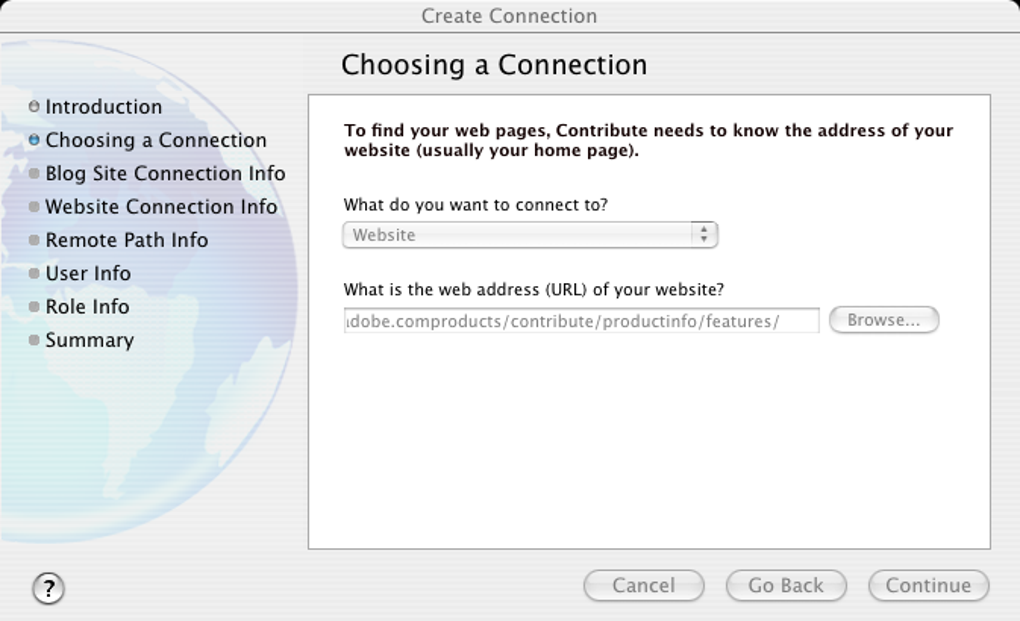Contributing your Mac’s idle processing power to the OpenMacGrid is very easy. However, before you do so, please make sure that your Mac has at least: 256 MB of Memory,1 GB of available hard disk space,G4 or better CPU andRunning Mac OS 10.4 (Tiger). Introducing the biggest ever free update for Adobe Captivate (2019 release) users. Create beautiful, mobile-ready courses in minutes with the all-new Quick Start Projects, ready-to-go slides and out-of-the-box interactions. Speed up course creation using automated branching and by copying appearance. Adobe Contribute 6.5 software is a powerful web publishing and website management tool that integrates authoring, reviewing, and publishing in an easy-to-use WYSIWYG HTML editor. Increase web publishing productivity while simplifying oversight and approval tasks.
Ways to Contribute to The Sgt. Contributions are made to the Sgt. Mac Foundation through many avenues. Financial contributions will help to fund programming and keep the Foundation active. There are also ways to assist the Foundation by pledging your time and efforts. Read on to find out how you can help. Contribute CS4 Mac Operating Systems Supported Mac OS System Requirements PowerPC G4 or G5 or multicore Intel processor Mac OS X v10.4.11–10.5.4 512MB of RAM.
| Developer Name | Adobe Systems Incorporated |
| Operating System | Mac OS |
The primary purpose of our website is to provide the user with a list of software programs that support a particular file extension, as well as that help to convert them to another format. Adobe Contribute for Mac supports 0 different file extensions, that's why it was found in our database. The following tables provide information about the association of Adobe Contribute for Mac with file extensions. If the Adobe Contribute for Mac program can be used to convert the file format to another one, such information will also be provided.

Associations of Adobe Contribute for Mac with the file extensions
Adobe Contribute for Mac converts the files:

What can I use this information for?
This information is especially useful when looking for a way to open a specific file. If you already have Adobe Contribute for Mac installed on your computer, you can check which file extensions it supports and look for the data you need in this specific format (or to what format you should convert the data so that you can open them in the Adobe Contribute for Mac).
I do not have a Adobe Contribute for Mac yet. Where should I get it?
By far the most safe way is to download Adobe Contribute for Mac directly from the developers's website. If you are going to download the Adobe Contribute for Mac from a website that offers a database of downloadable software, you have to reckon with the fact that when you install it on your computer, you will also install the unwanted extras. Please, pay special attention to this.
I cannot see the file extensions. What should I do?
File extensions are not normally displayed to users. To change this, go to Control Panel, select Appearance and Personalization and Folder Options. Next, select the View and find the option 'Hide extensions for known file types'. The option should be deselected (cleared) and confirmed with OK.
Mortgage closing costs range from 2-5% of a home’s purchase price. That can add up. But, many sellers are eager to pay your closing costs in order to sell their home faster.
There is a limit to how much a seller can pay for, though. Each loan type — conventional, FHA, VA, and USDA — sets maximums on seller-paid closing costs.
What are seller concessions?
Seller concessions are closing costs the seller has agreed to pay. These are also known as seller-paid costs, or sometimes as sales concessions or seller contributions. New and experienced homebuyers can get into homes faster with help from the seller.
In this article:
Seller contributions by loan type
Each loan type has slightly different rules when it comes to seller contributions. The percentage each loan type allows varies as well. It’s important to understand the seller-paid maximums for your loan type, so you can take full advantage when it comes time to buy.
Maximum seller-paid costs for conventional loans
Fannie Mae and Freddie Mac are the two rule makers for conventional loans. They set maximum seller-paid closing costs that are different from other loan types such as FHA and VA. While seller-paid cost amounts are capped, the limits are very generous.
A homebuyer purchasing a $250,000 house with 10% down could receive up to $15,000 in closing cost assistance (6% of the sales price). This dollar figure is a lot more than the typical seller is willing to contribute, so the limits won’t even be a factor in most cases.
| Property Type | Down Payment | Maximum Seller-Paid Costs |
| Primary residence or second home | less than 10% | 3% |
| Primary residence or second home | 10%-25% | 6% |
| Primary residence or second home | 25% or more | 9% |
| Investment Property | Any amount | 2% |
Source: Fannie Mae Selling Guide
FHA seller contributions
FHA seller concessions have similar rules to conventional loans. For all FHA loans, the seller and other interested parties can contribute up to 6% of the sales price or toward closing costs, prepaid expenses, discount points, and other financing concessions.
If the appraised home value is less than the purchase price, the seller may still contribute 6% of the value. FHA indictors that the lessor of the two (purchase versus appraised) values may be used.
VA loan seller contribution maximum
The seller may contribute up to 4% of the sale price, plus reasonable and customary loan costs on VA home loans. Total contributions may exceed 4% because standard closing costs do not count toward the total.
According to VA guidelines, the 4% rule only applies to items such as:
- Prepayment of property taxes and insurance
- Appliances and other gifts from the builder
- Discount points above 2% of the loan amount
- Payoff of the buyer’s judgments and debts
- Payment of the VA funding fee
For example, a buyer’s core closing costs for things like appraisal, loan origination, and the title equal 2% of the purchase price. The seller agrees to prepay taxes, insurance, the VA funding fee, and a credit card balance equal to 3% of the sales price.
Contribute For A Cake At Office
This 5% contribution would be allowed because 2% is going toward the core loan closing costs.
USDA seller contributions
USDA loan guidelines state that the seller may contribute up to 6% of the sales price toward the buyer’s reasonable closing costs. Guidelines also state that closing costs can’t exceed those charged by other applicants by the lender for similar transactions such as FHA-insured or VA-guaranteed mortgage loans.
Interested party contributions
Seller-paid costs fall within a broader category of real estate related funds called interested party contributions or IPCs. These costs are contributions that incentivize the homebuyer to buy that particular home. IPCs are allowed up to a certain dollar amount.
Who is considered an interested party? Your real estate agent, the home builder, and of course the home seller. Even funds from down payment assistance programs are considered IPCs if the funds originate from the seller and run through a non-profit.
Anyone who might benefit from the sale of the home is considered an interested party, and their contribution to the buyer is limited.
Why set maximum seller-paid closing costs?
Mortgage rule makers such as Fannie Mae, Freddie Mac, and HUD aim to keep the housing market fair by keeping values and prices sustainable.
Here’s an example of how rampant seller-paid closing costs and other interested party contributions could inflate prices.
Imagine you are buying a home worth $250,000. The seller really wants to sell the home fast, so he offers $25,000 to pay for your closing costs and says you can keep whatever is left over. But, in exchange he changes the home price to $275,000.
He then illegally pays the appraiser to establish a value of $275,000 for the home.
A number of negative consequences arise:
- You paid too much for the home.
- Similar homes in the neighborhood will start selling for $275,000 (and, more if the cycle is repeated).
- The bank’s loan amount is not based on the true value of the home.
In a very short time, property values and loan amounts are at unrealistic levels. If homeowners stop making their payments, banks and mortgage investors are left holding the bill.
Can the seller contribute more than actual closing costs?
No. The seller’s maximum contribution is the lesser of the sales price percentage determined by the loan type or the actual closing costs.
For instance, a homebuyer has $5,000 in closing costs and the maximum seller contribution amount is $10,000. The maximum the seller can contribute is $5,000 even though the limits are higher.
Seller contributions may not be used to help the buyer with the down payment, to reduce the borrower’s loan principal, or otherwise be kicked back to the buyer above the actual closing cost amount.
Creative ways to use excess seller contributions
While seller contributions are limited to actual closing costs, you can constructively increase your closing costs to use up all available funds.
Imagine the seller is willing to contribute $7,000, but your closing costs are only $5,000. That’s a whopping $2,000 is on the line.
In this situation, ask your lender to quote you specific costs to lower the rate. You could end up shaving 0.125%-0.25% off your rate using the excess seller contribution.
You can also use seller credits to prepay your homeowners insurance, taxes, and sometimes even HOA dues. Ask your lender and escrow agent if there are any sewer capacity charges and/or other transfer taxes or fees that you could pay for in advance. Chances are there is a way to use all the money available to you.

You can even use seller credit to pay upfront funding fees for government loan types like FHA.
Use seller contributions for upfront FHA, VA, and USDA fees
All government-backed loan types allow you to prepay funding fees with seller contributions.
FHA loans require an upfront mortgage insurance payment equal to 1.75% of the loan amount. The seller may pay this fee as part of FHA seller concessions. However, the entire fee must be paid by the seller. If you use excess seller credit, but it’s not enough to cover the entire upfront fee, then you cannot use the funds toward the fee.
VA loans allow the seller to pay all or part of the upfront fee (2.3%-3.6% of the loan amount). The fee counts towards VA’s 4% maximum contribution rule.
USDA requires an upfront guarantee fee of 2.0% of the loan amount. The buyer can use seller contributions to pay for it.
Seller contributions help many become owners
Seller contributions and other interested party credits reduce the amount of money it takes to get into a home.
Contribution Format Income Statement Excel
Zero-down loans such as USDA and VA require nothing down. But, opening any loan involves thousands in closing costs.
A seller credit can remove the closing cost barrier and help buyers get into homes for little or nothing out-of-pocket.
To see if you qualify to buy a home with zero down and low out-of-pocket expense, click here and complete a short form.
Contribute Macromedia
Many home shoppers are surprised that they not only qualify, but that initial homeownership costs are much lower than they expected.

Comments are closed.